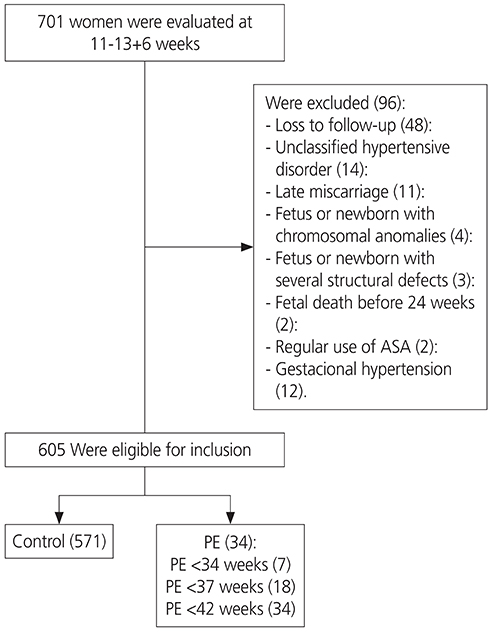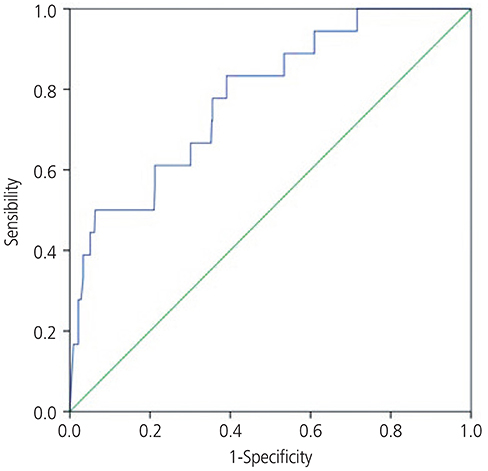Obstet Gynecol Sci.
2019 Nov;62(6):391-396. 10.5468/ogs.2019.62.6.391.
Prediction of preeclampsia in the first trimester of pregnancy using maternal characteristics, mean arterial pressure, and uterine artery Doppler data in a Brazilian population
- Affiliations
-
- 1Department of Obstetrics, Paulista School of Medicine, Federal University of São Paulo (EPM-UNIFESP), São Paulo, SP, Brazil. araujojred@terra.com.br
- KMID: 2462116
- DOI: http://doi.org/10.5468/ogs.2019.62.6.391
Abstract
OBJECTIVE
To evaluate the performance of the preeclampsia (PE) screening algorithm of the Fetal Medicine Foundation (FMF) during the first trimester in a Brazilian population using maternal characteristics, mean arterial pressure (MAP), and uterine artery Doppler data.
METHODS
This is a prospective cohort study that evaluated 701 pregnant women during the first trimester ultrasound screening for chromosomal abnormalities (11-13+6 weeks). All patients provided information regarding clinical and obstetric history, MAP, and mean uterine artery pulsatility index (mean PI). Patients were assigned to four groups based on the presence of PE and gestational age at delivery: group 1 (control), patients without hypertensive disorders (n=571); group 2, PE and delivery before 34 weeks of gestation (n=7); group 3, PE and delivery before 37 weeks of gestation, including patients from group 2 and patients that presented PE with delivery between 34 and 37 weeks (n=17); and group 4, PE and delivery before 42 weeks of gestation, including patients from both groups 2 and 3 and patients that presented PE with delivery between 37 and 42 weeks of gestation (n=34).
RESULTS
After the exclusion of 96 patients, we evaluated the data of 605 patients. By combining maternal characteristics, MAP, and the mean uterine artery PI for the detection of PE, we found a sensitivity of 71.4% in group 2, 50% in group 3, and 41.2% in group 4 (false positive rate=10%).
CONCLUSION
Using maternal characteristics, MAP, and uterine artery Doppler data, we were able to identify a significant proportion of patients who developed preterm PE.
MeSH Terms
Figure
Reference
-
1. Lewis G. Reviewing maternal deaths to make pregnancy safer. Best Pract Res Clin Obstet Gynaecol. 2008; 22:447–463.
Article2. ACOG Committee on Obstetric Practice. American College of Obstetricians and Gynecologists. ACOG practice bulletin. Diagnosis and management of preeclampsia and eclampsia. Number 33, January 2002. Int J Gynaecol Obstet. 2002; 77:67–75.3. World Health Organization. Make every mother and child count. Geneva: World Health Organization;2005.4. Weindling AM. The confidential enquiry into maternal and child health (CEMACH). Arch Dis Child. 2003; 88:1034–1037.
Article5. Martins AL. Maternal mortality among black women in Brazil. Cad Saude Publica. 2006; 22:2473–2479.6. Zanette E, Parpinelli MA, Surita FG, Costa ML, Haddad SM, Sousa MH, et al. Maternal near miss and death among women with severe hypertensive disorders: a Brazilian multicenter surveillance study. Reprod Health. 2014; 11:4.
Article7. Report of the national high blood pressure education program working group on high blood pressure in pregnancy. Am J Obstet Gynecol. 2000; 183:S1–22.8. Ness RB, Roberts JM. Heterogeneous causes constituting the single syndrome of preeclampsia: a hypothesis and its implications. Am J Obstet Gynecol. 1996; 175:1365–1370.
Article9. Bujold E, Roberge S, Lacasse Y, Bureau M, Audibert F, Marcoux S, et al. Prevention of preeclampsia and intrauterine growth restriction with aspirin started in early pregnancy: a meta-analysis. Obstet Gynecol. 2010; 116:402–414.10. Martin AM, Bindra R, Curcio P, Cicero S, Nicolaides KH. Screening for pre-eclampsia and fetal growth restriction by uterine artery Doppler at 11–14 weeks of gestation. Ultrasound Obstet Gynecol. 2001; 18:583–586.
Article11. Plasencia W, Maiz N, Bonino S, Kaihura C, Nicolaides KH. Uterine artery Doppler at 11 + 0 to 13 + 6 weeks in the prediction of pre-eclampsia. Ultrasound Obstet Gynecol. 2007; 30:742–749.
Article12. Yu CK, Smith GC, Papageorghiou AT, Cacho AM, Nicolaides KH. Fetal Medicine Foundation Second Trimester Screening Group. An integrated model for the prediction of preeclampsia using maternal factors and uterine artery Doppler velocimetry in unselected low-risk women. Am J Obstet Gynecol. 2005; 193:429–436.
Article13. Poon LC, Nicolaides KH. Early prediction of preeclampsia. Obstet Gynecol Int. 2014; 2014:297397.
Article14. Rolnik DL, Wright D, Poon LC, Syngelaki A, O'Gorman N, de Paco Matallana C, et al. ASPRE trial: performance of screening for preterm pre-eclampsia. Ultrasound Obstet Gynecol. 2017; 50:492–495.
Article
- Full Text Links
- Actions
-
Cited
- CITED
-
- Close
- Share
- Similar articles
-
- Predictive Value of Maternal Serum Markers for Preeclampsia
- Uterine Artery Doppler Velocimetry as a Screening Test in the Second Trimester Pregnancies
- The Relationship of Early Diastolic Notch in Uterine Artery Doppler Velocimetry and the Renal Function of Patients with Pregnancy Induced Hypertension
- Uterine artery Doppler velocimetry in the prediction of adverse obstetric outcomes in unexplained MSAFP elevations
- A study of the factors associated with the pattern of gestational weight gain



